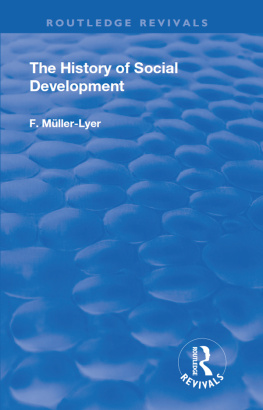First published in 1930 by Alfred A. Knopf
This edition first published in 2018 by Routledge
2 Park Square, Milton Park, Abingdon, Oxon, OX14 4RN
and by Routledge
711 Third Avenue, New York, NY 10017
Routledge is an imprint of the Taylor & Francis Group, an informa business
1930 Taylor & Francis
All rights reserved. No part of this book may be reprinted or reproduced or utilised in any form or by any electronic, mechanical, or other means, now known or hereafter invented, including photocopying and recording, or in any information storage or retrieval system, without permission in writing from the publishers.
Publishers Note
The publisher has gone to great lengths to ensure the quality of this reprint but points out that some imperfections in the original copies may be apparent.
Disclaimer
The publisher has made every effort to trace copyright holders and welcomes correspondence from those they have been unable to contact.
A Library of Congress record exists under ISBN: 30013205
ISBN 13: 978-1-138-55416-0 (hbk)
ISBN 13: 978-0-203-70529-2 (ebk)
THE EVOLUTION OF MODERN MARRIAGE
BY THE SAME AUTHOR
THE HISTORY OF SOCIAL DEVELOPMENT
The vast learning, the broad sweep of thought, combined with the wealth of interesting detail, make it one of the most valuable as well as most fascinating of modern works on human history. It has the charm of a romance. Economic Review.
A monument of human patience and erudition certainly the result of such labour is to prove beyond contradiction that mans most fascinating study is the study of himself.Education.
It is a book that ought to find a place on the shelves of every working-class student, and no tutor should be without it.Highway.
The German original, entitled Phasen der Liebe, was published in Munich in 1913
FIRST PUBLISHED IN THE U.S.A. IN 1930
All rights reserved
PRINTED IN GREAT BRITAIN BY
UNWIN BROTHERS LTD., WOKING
TRANSLATORS PREFACE
ALTHOUGH Mller-Lyer published Phasen der Liebe in 1913, the book contains so much of value for the present day that I have thought it worthy of translating for the English-speaking public sixteen years later.
So many books on marriage leave one with a feeling of chaos that it is important to examine any document undertaking the discovery of order by searching for underlying tendencies.
The author emphasizes the necessity of taking the evolutionary point of view, and sees in militant feminism, which teaches emulation of men, a phase which will pass as women come to make their own peculiar spiritual contribution to civilization as men have done. Perhaps this will come the sooner, he suggests, if women will regard themselves as the equivalents and not as the equals of men.
Mller-Lyer maintains that complete economic independence of women is necessary. We believe he means by this that each partner should feel the responsibility of contributing to the marriage real wages in the best economic sense, and not that an attempt should be made to match dollar for dollar.
Whether we agree with our authors thesis or not, his work is valuable for its superb documentary evidence, so often lacking in sociological work. The intelligent public will want the material upon which the author has based his conclusions, as well as the interpretations of an expert.
CAMBRIDGE, MASSACHUSETTS,
February 1929
PREFACE
Of a series which I propose to call Die Entwicklungsstufen der Menschheit, there have appeared to date, Der Sinn des Lebens, Phasen der Kultur, Formen der Ehe, and Die Familie. These, with the present volume and the ensuing ones, will, it is hoped, constitute a unified systematic sociology1 (cf. the general plan at the end of the book). However, each book is an entity in itself, and should be comprehensible without reference to the others. The present volume, The Evolution of Modem Marriage, then, is closely connected with the last two volumes on geneonomy, but is so planned that it will require only a short introduction.
By Geneonomy we understand the sum of all those expressions of social life that have reference to the preservation of the species, i.e. all those manifestations that have for their purpose the compensation of passing generations by future ones or are directly connected with it. As we have stated elsewhere, these are in outline form2:
A. THE SEXUAL RELATIONSHIP (i.e. the relations between man and woman); in particular
1. Love.
2. Motives for Marriage.
3. Obtaining Wives.
4. Marriage.
5. Social Position of Woman.
B. THE RELATIONS BETWEEN GENERATIONS (i.e. the relations between parents and children, or, more generally, between the older and younger generation).
1. Family.
2. Natural Selection.
3. Education.
4. Inheritance.
5. Social Position of Old Age.
C. CLAN RELATIONS.
1. Clan.
2. Consanguinity Systems.
3. Marriage Regulations.
In the preceding book (Die Familie) we have reviewed all these geneonomical manifestations, and have divided the stages of their evolution in the following manner:
1. CLAN EPOCH: where human society is built upon the principle of common ancestry, of blood relationship, whose prototype is the clan. This epoch again falls into three phases: in the early clan phase the clan gradually reached its greatest differentiation; in the high clan phase it flourished to the grektest extent; in the late clan phase the clan, which up to now had been the foundation of society, gradually disintegrated as a result of a great evolutionary upheaval that led into
2. THE FAMILY EPOCH.In this reorganization the clan was split up into the individual families that it had previously held together: the family now assumes the clans economic functions, while a new element, the state, assumes the clans political responsibilities and becomes increasingly powerful. As in the tribal epoch, the family epoch also falls into three phasesits rise, the early family phase; its flower, the high family phase; and its decline, the late family phase, which coincides with the rise of capitalistic production.
Unless present indications deceive us, we stand to-day at the threshold of a new epochal transition, an epoch wherein the individual, the personality, comes to the fore, and which is hence called
3. THE INDIVIDUAL OR PERSONAL EPOCH.Of this epoch we can know only the first beginnings, namely, the early personal phase that has begun with the differentiation of women.
Obviously, more than one principle of organization existed at any one time during these different epochs; we mean to indicate merely that in the first epoch the clan, in the second the family, and in the third the individual, is to be considered as more dominant than both the others.








